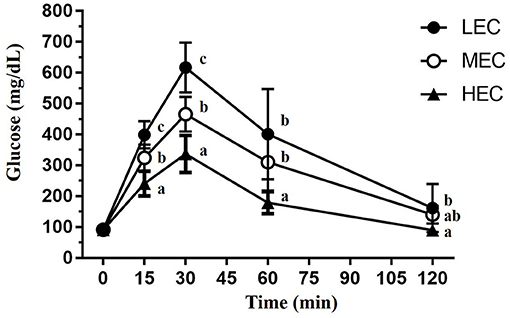
95% of researchers rate our articles as excellent or good
Learn more about the work of our research integrity team to safeguard the quality of each article we publish.
Find out more
CORRECTION article
Front. Physiol. , 17 October 2019
Sec. Exercise Physiology
Volume 10 - 2019 | https://doi.org/10.3389/fphys.2019.01327
This article is part of the Research Topic Predicting Individual Responses to Exercise Interventions View all 16 articles
This article is a correction to:
Investigation of the Effects of Microbiota on Exercise Physiological Adaption, Performance, and Energy Utilization Using a Gnotobiotic Animal Model
A Corrigendum on
Physiological and Biochemical Effects of Intrinsically High and Low Exercise Capacities Through Multiomics Approaches
by Tung, Y.-T., Hsu, Y.-J., Liao, C.-C., Ho, S.-T., Huang, C.-C., and Huang, W.-C. (2019). Front. Physiol. 10:1201. doi: 10.3389/fphys.2019.01201
In the original article, there was a mistake in Figure 5 as published. The incorrect Figure 5 was erroneously uploaded at submission. Furthermore, all data should be represented as mean with SD, however, the original Figure 5 shows mean with SEM. Lastly, the statistical results in the original Figure 5 are correct, however, the way in which it is displayed is incorrect. The statistical letters should start from a, b, and c according to the mean average. The corrected Figure 5 appears below.

Figure 5. The oral glucose tolerance test was performed in mice with various exercise capacities at the same glucose dosage (2 g/kg) after 14 h of fasting. The indicated sampling times (0, 15, 30, 60, and 120 min) were plotted as the tolerance curve. Data are presented as mean ± standard deviation for 15 mice in each group. Different letters (a,b,c) indicate a significant difference at p < 0.05 using one-way ANOVA.
The authors apologize for this error and state that this does not change the scientific conclusions of the article in any way. The original article has been updated.
Keywords: intrinsic exercise capacity, physical activities, gut microbiota, transcriptome, proteome
Citation: Tung Y-T, Hsu Y-J, Liao C-C, Ho S-T, Huang C-C and Huang W-C (2019) Corrigendum: Physiological and Biochemical Effects of Intrinsically High and Low Exercise Capacities Through Multiomics Approaches. Front. Physiol. 10:1327. doi: 10.3389/fphys.2019.01327
Received: 21 September 2019; Accepted: 03 October 2019;
Published: 17 October 2019.
Edited and reviewed by: Vassilis Mougios, Aristotle University of Thessaloniki, Greece
Copyright © 2019 Tung, Hsu, Liao, Ho, Huang and Huang. This is an open-access article distributed under the terms of the Creative Commons Attribution License (CC BY). The use, distribution or reproduction in other forums is permitted, provided the original author(s) and the copyright owner(s) are credited and that the original publication in this journal is cited, in accordance with accepted academic practice. No use, distribution or reproduction is permitted which does not comply with these terms.
*Correspondence: Chi-Chang Huang, am9objU1MjNAbnRzdS5lZHUudHc=; Wen-Ching Huang, d2VuY2hpbmdAbnR1bmhzLmVkdS50dw==
Disclaimer: All claims expressed in this article are solely those of the authors and do not necessarily represent those of their affiliated organizations, or those of the publisher, the editors and the reviewers. Any product that may be evaluated in this article or claim that may be made by its manufacturer is not guaranteed or endorsed by the publisher.
Research integrity at Frontiers

Learn more about the work of our research integrity team to safeguard the quality of each article we publish.